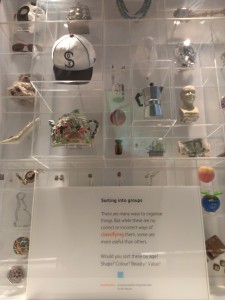Currency typology: The Trusted Third Party
 A reminder from the Natural History Museum in London:
A reminder from the Natural History Museum in London:
“There are many ways of organise things. But while there are no correct and incorrect ways of classifying them, some are more useful than others. Would you sort these by age? Shape? Colour? Beauty? Value?”
Often complementary currencies seem to be treated like the contents of a kitchen cabinet and get categorized and presented along some common attributes, like:
- the issuance mechanism or entity: e.g. “fiat”-currency, “private”-currency or “mutual credit”-currency etc.
- their objectives: e.g. “social”-currency, “community”-currency, “green”-currency, “capacity trade”-currency, “loyalty”-currency, “reputation”-currency etc.
- the material or technical implementation of the units or accounts: “paper”-currency, “digital”-currency, “virtual”-currency, “online”-currency, “mobile”-currency etc.
- the geographic scale: e.g. “global”-currency, “national”-currency, “regional”-currency, “local”-currency etc.
- some particular attribute or functionality of its use: e.g. “legal tender”-currency, “business-barter”-currency, “crypto”-currency, “demurrage”-currency etc.
- the transaction partners: e.g. “business-to-business(b2b)”, “business-to-client(b2c), “peer-to-peer(p2p)”-currency etc.
- the units relation to some other value or asset: “energy”-currency, “gold”-currency, “commodity”-currency, “time”-currency etc.
- or even some popular brandings: e.g. “LETS”, “time-bank”, “Trueque”, “Free-Currency”, “Sript-“Regiogeld”, etc.
These descriptions are helpful particularly for a first glance of the scope and diversity of currency applications. But most of these perspectives overlap each other and neither relates all currencies in a basic spectrum that provides clear guidance and progression to the very understanding of currency per se.
Alternatively, some authors retrace the historic developments of the predominant form of currency (money)1, which can lead to very helpful contrasting juxtapositions and sets the scope of what needs to be covered by any new typology.
Particularly the above labels illustrate, how such approaches are similar to a fictive attempt to sort the chemical elements by the use for different consumer products. For argument’s sake it might be interesting for industry to distinguish chemical elements used e.g. in electronics from those used in construction material. For a chemist, this is not appropriate. Or to stick with the Biological context as above: Grouping plants, algae and mushrooms together, might serve for children to understand their environment or the horticulturist and aquarist to plan their artificial biotopes but for a molecular or evolutionary biologist, they are far from being of the same realm.2
In earlier blog posts, first an approximate definition of “currency” has been attempted (see here), and secondly a categorization of currencies by their “representational charge” along the basic observed functions of currencies as unit of account, means of exchange, store of value was explored (see here).
Here, a second “dimension” of currency categorization is proposed which orientates itself along the arrangement of a trusted third party, that a currency design institutes explicitly or implicitly. The preliminary denomination of the spectrum is the “disintermediation of trust”.
Relating closely to the legacy analysis of E.C. Riegel, Thomas Greco and Bernard Lietaer, this dimension distinguishes currencies according to how the trusted third party element is construed in their design.
Trust is widely recognized as a basic determinant for the functionality of a currency. This is often allured to by the use and description of trust proxis, implicitly by backing a currency with legal tender or commodities), or explicitly by saying the value of a currency lies in its user community. Looking at currencies as implementations of contractual frameworks helps to understand this notion and sheds light on the rather obscure constellations as present for example in legal tender currencies where such contracts originate somewhere between state constitutions and law, assumed adherence to these by birth or citizenship, negotiated through political process and implemented by a mostly privatized banking system
Explicitly looking into or for the trusted third party in any currency design thus provides an important epistemological pathway and secondly a constitutes generic way of differentiating currencies which, by merit of its universality, could be a good candidate for an ontological approach to currency typology. The most useful descriptors along this dimension remain to be determined, here are some suggestions:
The “Trusted Third Party” dimension
<——————————————————————————————————>
“centralized/ vs “disintermediated(p2p)/ externalized/…” internalized/…”
This can serve as a second dimension to be combined with the “representational charge dimension” (as proposed in this earlier article) into a preliminary two-dimensional matrix. This second dimension would go orthogonally thought the “unit of account” point of the representational charge dimension as repositioned in this amendment.
The placement of existing currencies in this will be attempted in a future article. Also, the “Trusted Third Party” dimension poses some immediate questions as to the positioning of e.g. Gold as a commonly perceived “trust-guarantor”. This necessitates the role of market derived value (as for gold) vs. more intrinsic or absolute values (as e.g. an hour of life-time). A good candidate for this inquiry might be the reflection on value and wealth by Henry George, for example in his book “The Science of Political Economy”.
To be continued… (subscribe to this blog for updates.)
1: Thomas Greco “Evolution and Transformation of Money” slide show, accessible here.
2: For the biologically inclined: Mushrooms are molecularly closer related to animals than to plants (see here) and algae are not a subset of the plant kingdom (see here).